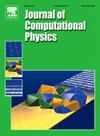A family of provable Lp stable and boundedness preserving high order Runge-Kutta discrete exterior calculus discretization for conservative phase field method
IF 3.8
2区 物理与天体物理
Q2 COMPUTER SCIENCE, INTERDISCIPLINARY APPLICATIONS
引用次数: 0
Abstract
Conservative phase field (PF) equation and its axisymmetric version are expressed under the discrete exterior calculus (DEC) framework. The boundedness proof [1] of conservative PF method in the DEC framework is extended to its axisymmetric version. A sufficient condition for boundedness of conservative PF method and its axisymmetric version with Runge-Kutta (RK) time integration scheme has been proved. By this sufficient condition, the boundedness proof of the method for Euler forward time integration scheme has been extended to high order RK time integration schemes, such as Heun's method, classical third order RK method and a five stages fourth order RK method, which is independent of spatial discretization method, i.e. not limited to the DEC framework. The conservation and stability for of conservative PF method and its axisymmetric version are also proved in the DEC framework. Several two phase advection simulations on 2D Riemannian manifolds and its axisymmetric version for interface capturing are presented, which verify the proved properties of phase field, i.e. conservation, stability and boundedness.
保守相场法的一类可证明的Lp稳定有界保持高阶龙格-库塔离散外微积分离散化
在离散外演算(DEC)框架下,给出了守恒相场方程及其轴对称形式。将保守PF方法在DEC框架下的有界证明[1]推广到它的轴对称版本。证明了保守PF方法及其轴对称版本的龙格-库塔(RK)时间积分格式有界性的一个充分条件。利用这一充分条件,将欧拉正演时间积分方案方法的有界性证明推广到Heun方法、经典三阶RK方法和五阶四阶RK方法等高阶RK时间积分方案,这些方案不依赖于空间离散化方法,即不局限于DEC框架。在DEC框架下证明了保守PF方法及其轴对称版本在1≤p≤∞时的守恒性和Lp稳定性。给出了二维黎曼流形及其轴对称版本的界面捕获两相平流模拟,验证了相场的守恒性、Lp稳定性和有界性。
本文章由计算机程序翻译,如有差异,请以英文原文为准。
求助全文
约1分钟内获得全文
求助全文
来源期刊

Journal of Computational Physics
物理-计算机:跨学科应用
CiteScore
7.60
自引率
14.60%
发文量
763
审稿时长
5.8 months
期刊介绍:
Journal of Computational Physics thoroughly treats the computational aspects of physical problems, presenting techniques for the numerical solution of mathematical equations arising in all areas of physics. The journal seeks to emphasize methods that cross disciplinary boundaries.
The Journal of Computational Physics also publishes short notes of 4 pages or less (including figures, tables, and references but excluding title pages). Letters to the Editor commenting on articles already published in this Journal will also be considered. Neither notes nor letters should have an abstract.
 求助内容:
求助内容: 应助结果提醒方式:
应助结果提醒方式:


